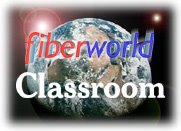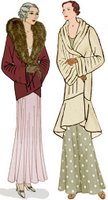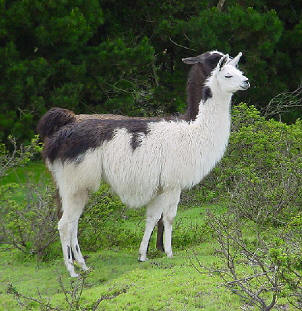Friday, February 09, 2007
Museum: New at FIT
Thursday, March 29
6:00pm - 7:00pm
Marvin Feldman Center (C-Building), 9th floor Boardroom
Berets, beanies, and baseball caps . . . all familiar terms, but have you ever wondered what a cloche is or what a milliner does? Join Ellen Goldstein, chairperson of Accessory Design at FIT, for an illustrated lecture on the artistry and allure of hats and hat making. "Hats 101" is offered in conjunction with the exhibition Lilly Daché: Glamour at the Drop of a Hat.
Sunday, February 04, 2007
Exhibition: Radical Lace and Subversive Knitting

Today I had a chance to experience the exhibit Radical Lace and Subversive Knitting at the Museum of Arts and Design. Here is a summary for those who are unable to attend or incentive for those who are considering attending this inspiring and thought-provoking installation.
The Facts
Who: The Museum of Arts and Design. Information: (212) 956-3535 or at madmuseum.org. The exhibition showcases the works of over 27 artists from seven different countries. Some names were familiar to me, including David Cole who created the giant American flag knit with 20 foot long knitting needles on cranes, and Cat Mazza who designed the knitpro web application to create knitting charts of corporate logos and organizes microRevolt to help to increase awareness of the inhumanity of sweatshop labor. You may know some or all of the other artists even though I did not.
What: Radical Lace and Subversive Knitting. What it really is and what it is not: This is not a comprehensive overview of the changing role of textile arts in today's chaotic world. In fact, it's not really a comprehensive anything. There is not much traditional knit, crochet or tatting or historical reference that would serve as basis for understanding. Even though I was aware of some of the titular radical and subversive events, and had the help of the museum's placards, I needed to do some web research when I got home to get a deeper, cohesive understanding of the installation as a whole. The exhibit does include several examples of items knit of novel textiles, like newspapers. There are pieces that display a contemporary twist to the craft, like a crochet doily with skulls. And then there are the more conceptual creations "knit" of rubber, metal, and porcelain. There are modern adaptations of textile arts utilizing computers and video. Many of the works have a message or meaning that speaks directly to modern mess in which we live. According to the brochure, the exhibit had six general themes: corporeal constructions referencing the human body; matters of scale examining size; light constructions exlploring the integral role of light; interconnections that focus on human interaction; creative deconstructions focusing on subtractive processes; and the beauty of complexity focusing on intricacy and manipulation of the materials. I had a chance to thumb through the exhibition's guide book, and it is full of additional pictures and information. I wish I had the (approximately) $40 for it.
Where: MAD is located at 40 West 53rd Street, between 5th and 6th Avenues (Avenue of the Americas) in New York City. It is conveniently situated across the street from the Museum of Modern Art and the American Folk Art Museum. (Note: Even if you don't or can't visit MoMA, take a moment to visit their store which is famous for beautiful and useful items.) As a side note, the MAD gallery is an open, light-filled filled space that supports this installation beautifully. It is spread over three levels connected by a semi-circular staircase.
When: through June 17, 2007. Museum hours: Daily, 10 a.m. to 6 p.m. (until 8 p.m. on Thursdays); closed on holidays. Please take a moment to look at their schedule of upcoming informational programs (available as a PDF on the exhibition's webpage - scroll down.) The museum is offering a dozen educational and social (and socially conscious!) events until June. Most are free; some workshops have a fee ($25-$100). My favorite is May 17th's four hour "Knit Night". I cannot believe I missed the January 29th edible lace workshop. Sigh.
How: Directions are available on MAD's website. Admission is $9 - $7 for students and seniors; and pay-what-you-wish on Thursdays after 6 p.m.
Finally, why: I wanted to touch every exhibit! It was torture not to touch. About halfway through, I had tears in my eyes and I wanted to run home immediately to work on my very non-subversive scarf. It was truly inspiring. On one hand, it reminded me of what I consider to be the basic drive for my knitting (loosely stolen from Brenda Dane of the fabulous Cast-on podcast): I think I'm hot shit because I can make fabric out of string and two pointy sticks. (I can also make tubular fabric out of string and four pointy sticks, but I ain't braggin'.) On the other hand, it reminded me of the simple beauty of the art form: the complex interaction of space and textile, whether it be yarn, paper, wire, rubber, glass... You get the idea. It expanding my horizons. My non-knitting boyfriend enjoyed the exhibit as well. Favorite pieces: Absolute fave... Maybe the beautiful, size 8 evening dress knit from 890 dollar bills. My boyfriend loved a piece, untitled by Hilal Sami Hilal - a Brazilian artist, that was a giant matrix of cotton fiber and letters. I'm sorry I cannot find you a picture (one is in the exhibit's brochure) as it is indescribable. Also inspiring (as in, I'm gonna try something like this) was a bobbin lace lamp of fiber optic wire, and a collection of realistic, knit snake skins.
One of my favorite parts: Definitely take a moment to pause right after you pass the security guard when entering the museum proper to look down to the lowest level to watch the knitters in the provided social knitting space. I so wish my boyfriend could have snapped a photo. On the lowest level, the museum has provided a table with yarn and needles for people to knit together, or you can bring your own project. My wonderful boyfriend offered to stay so I could knit a bit, but I'm shy... Maybe next time.
But don't take my word for it: Some potentially useful links, with as many unique pictures as I could find for you: The New York Times reviewed the exhibition here. Craftzine.com has a blog entry here . Also, the Greenjeans blog has excellent information and pictures here.
If anyone attends, and would like to comment, it would be most appreciated. Also, please feel free to leave a comment of other socially conscious textile art groups or events that I haven't mentioned. (In addition to those listed in the Who section and at the exhibit, see also the knit-fitti of knit parking meter cosies.)
Saturday, November 11, 2006
NYT: Identifying Diamonds
From the 5 July 2006 New York Times:
At This Lab, No Stone is left Unturned or Unmarked
One of the features making Gem Certification and Assurance certificates effective is the use of a device called Gemprint, which, by shining a laser through a diamond, captures its unique sparkle pattern, just like a human fingerprint. A copy of this Gemprint image goes on each G.C.A.L. certificate, making it impossible to switch stones or claim a stone is better than it really is. The guarantee can only be thwarted by completely recutting a diamond, at a considerable loss in size and value.
Once G.C.A.L. has certified a diamond, company experts use a cold laser to engrave a logo and serial number onto its rim, though Mr. Palmieri admits that such markings, only a few microns deep, could be easily removed.
NYT: Earliest Jewelry
From the 23 June 2006 New York Times:
Old Shells Suggest Early Human Adornment
Archaeologists say they have found evidence that in one respect people were behaving like thoroughly modern humans as early as 100,000 years ago: they were apparently decorating themselves with a kind of status-defining jewelry -- the earliest known shell necklaces.
If this interpretation is correct, it means that human self-adornment, considered a manifestation of symbolic thinking, was practiced at least 25,000 years earlier than previously thought.
Jewelry was probably one of the earliest ways people conveyed aspects of their social and cultural identities.
Sunday, August 06, 2006
Style.com Fall 2006 Trend Reports


No real news here, but check out the pretty pictures at Style.com's Trend Report for Fall 2006. Their picks include:
- the bubble (dress, skirts AND coats);
- fur, in colors like champagne, fuscia, and blue
- metalics
- oversized
- layering
- Napoleonic
Books: Sale at the Selvedge bookstore
Sunday, July 23, 2006
Website: Fibersource

Tuesday, July 18, 2006
Book: Fashion Advertising and Promotion
 Fashion Advertising and Promotion by Jay Diamond. (If you don't recall, Monsieur Diamond was the author of our Introduction to the Fashion Industry textbook: World of Fashion.)
Fashion Advertising and Promotion by Jay Diamond. (If you don't recall, Monsieur Diamond was the author of our Introduction to the Fashion Industry textbook: World of Fashion.)
New Blog: Aesthetics and Economics
From the author's bio: I am a 20 year-old college student in Washington, DC studying international economics. Aesthetics + Economics is my attempt to find an outlet for an intense interest in fashion and design in general, and to find interlocutors so that I might refine my knowledge of the inner workings of fashion and the design-oriented business world.
Especially interesting: A recent commentary on a Wall Street Journal article on the changing face of the luxury department store.
Sunday, July 09, 2006
Fall 2006: Chanel Couture
 Check out the Fall 2006 Chanel Couture collection at Style.com. Key looks include: thigh high denim boots with matching gauntlets, tunic dresses, and luxury embellishments like lush embroidery and large, dazzling gems.
Check out the Fall 2006 Chanel Couture collection at Style.com. Key looks include: thigh high denim boots with matching gauntlets, tunic dresses, and luxury embellishments like lush embroidery and large, dazzling gems.I totally love this look, and plan on interpreting it for myself.
Also see a fellow fashion blogger's opinion at Aesthetics and Economics.
New Trends in the Fashion Industry
I recently read of two new trends in the fashion industry. The first is demi-couture, defined as an intermediate level of luxury between pret-a-porter and couture.
Also on the rise is the concept of additional fashion seasons. We've recently discovered the importance of Resort collections as an early indicator of Spring styles. Now, designers are utilizing ato help lessen the risk of relying solely on the Fall collections.
Sunday, June 25, 2006
General: Presentation Pet Peeves
Sunday, June 18, 2006
Book: Fairchild Encyclopedia of Fashion Accessories
Fairchild Encyclopedia of Fashion Accessories
Sewing Project: You Decide

Parisienne Coat - authentic vintage pattern from 1931. You decide: cool? I'm thinking of sewing the coat on the right, with optional flounce, in a solid color... From Decades of Style Patterns. $20.
Resort 2007: Oscar de la Renta

Check out Oscar de la Renta's Resort 2007 collection. Lots of what you would expect: black/white, navy/white, crochet, nude textured hose - but done nicely. Very wearable.
Product Knowledge: Shoes: John Fluevog, again

I can't help it. I love his shoes. This is the new, limited edition Tracey. According to the e-mail, this is Fluevog's highest heel yet. $179.
The Camelids: A Picture Review
Alpaca

Llama

Guanaco

Vicuna



The Vicuna
 Long overdue, some information on the wonderful Vicuna.
Long overdue, some information on the wonderful Vicuna.Vicunas are the spirit and the life blood of the camelid families living in the high Andes. Unfortunately, due to their very valuable fleece vicunas were nearly hunted to extinction by the late l970s. Conservation efforts in Peru, Chile and Argentina have led to a phenomenal resurgence in vicuna populations. Once again, due to careful management, vicunas can be found in healthy numbers in the Andes.
Vicunas (Vicugna vicugna) are members of the Camelidae family, of which there are three other living members in South America: the wild guanaco (Lama guanacoe), the domestic llama (Lama glama), and the alpaca (Lama pacos).
 The smallest of all camels, the vicuna weighs about 90 pounds and stands just under three feet at the shoulder. Like all South American camel species, the vicuna has a long, supple neck; slender legs; padded, cloven feet; large round eyes; and a dense and fine tawny coat.
The smallest of all camels, the vicuna weighs about 90 pounds and stands just under three feet at the shoulder. Like all South American camel species, the vicuna has a long, supple neck; slender legs; padded, cloven feet; large round eyes; and a dense and fine tawny coat.The vicuna is a hardy survivor adapted to high altitudes, where drought and freezing nights are the rule. It is a natural pacer and well designed to travel fast for great distances. Keen eyesight allows early detection for flights to safety.
 The vicuna is the probable wild progenitor of the domestic alpaca, which was created by selective breeding about 6000 years ago. Entirely wild, vicunas live in small family groups led by a single territorial male that vigilantly repels rival males and small predators threatening the young. After 11 months of gestation, vicuna mothers give birth to one baby, known as a cria.
The vicuna is the probable wild progenitor of the domestic alpaca, which was created by selective breeding about 6000 years ago. Entirely wild, vicunas live in small family groups led by a single territorial male that vigilantly repels rival males and small predators threatening the young. After 11 months of gestation, vicuna mothers give birth to one baby, known as a cria.
Vicunas are highly communicative, signaling one another with body postures, ear and tail placement, and numerous other subtle movements. Their vocalizations include an alarm call -- a high pitched whinny -- that alerts the herd to danger. They also emit a soft humming sound to signal bonding or greeting and a range of guttural sounds that communicate anger and fear. "Orgling" is probably their most unique noise. This male-only, melodic mating sound attracts unbred females.
(Stolen without shame from: Bonny Doon Alpacas: Breeding Beauty in the Fleece.)
